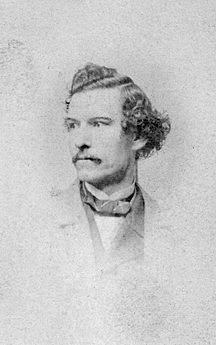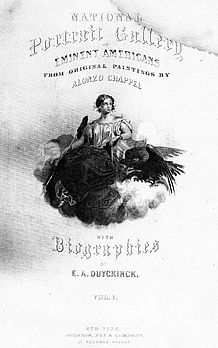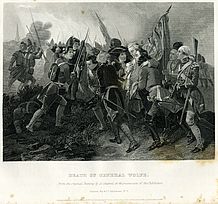Portrait of Alonzo Chappel as Artist
Born in 1828 in the Bowery in Lower Manhattan, Alonzo Chappel [Image 41] began his illustrating career at the early age of nine, submitting a portrait of Washington entitled The Father of His Country to the American Institute Fair. By the time he was twelve, Chappel was working the streets of Manhattan, charging between five and ten dollars for portraits. He dropped out of school at fourteen to study the arts of japanning and window-shade painting, and by sixteen he was listed in the New York City Directory as a portrait artist earning twenty-five dollars a painting. While he earned spare money painting stage scenery for plays in Manhattan, Chappel took art lessons from Samuel F. B. Morse, and it was through Morse that he was first exposed to European artistic conventions. His interests in these techniques were honed over the next few decades, as Chappel came into contact with painters like George Inness with whom he helped establish the Brooklyn Art Association. Unlike the crude vernacular forms of Croome, Chappel practiced a form of portraiture in the “grand manner” based on the monumental style common to Benjamin West in England, Emanuel Leutze of the Dusseldorf school in Germany, and Paul Delaroche in Paris. These history painters viewed themselves as not merely literal transcribers of events but as interpreters of their philosophical and historical meanings. Their style included the use of heavy symbolism, bordering on the allegorical, as well as sentimental depictions of figures rendered in heroic casts. Chappel’s work as a painter and later as a book illustrator for Johnson’s Eminent Americans was informed by these trends. [52] [Image 42]
Like many such artists with aspirations in his day, Chappel participated in gallery exhibitions at places such as the National Academy of Design where visitors paid for the privilege of viewing his paintings, but for the most part such commissions were not lucrative. Consequently, he supplemented his income by working as a book illustrator not only to put food on the table but also to provide promotional opportunities for the further marketing of his painted images. Painters who had been previously at the mercy of wealthy patrons who dictated the subject matter and style of their work now recognized an opportunity to reach the masses with visual imagery of their own making.
By the 1850s, Chappel was so busy as a painter and book illustrator that he moved his operations to Long Island, where he hired a group of young artists to translate his oil paintings into lithographs for the pictorial book and print markets. Known as “Chappel’s factory,” this colony of artists was so prolific and yet inconsistent in its work that the phrase “based on an original oil painting by Alonzo Chappel” adorning so many of his illustrations in historical works and popular prints became synonymous with mechanized or processed art. The overuse of this inscription on hundreds of illustrations caused one art critic to question the existence of Chappel altogether. “All the so-called Chappel pictures are made up,” he wrote. “I have heard it said there is no Chappel. It is merely a named used.” [53]
Chappel did exist, of course, but it is hard to this day to determine the true extent and value of his artistic corpus. Many of Chappel’s most outstanding oil paintings were never appreciated fully by American audiences, held as they were in the private collections of publishers and print makers who circulated numerous and sometimes inferior reproductions of such images in books and lithographs. Because so many of these originals were lost subsequently, Chappel’s reputation as a painter has rested (often to his disadvantage) largely on the inferior copies of original works that were engraved by his employees for pictorial markets. [54]
Compare Chappel’s “Death of General Wolfe” [Image 42a] to Croome’s and West’s works on the same subject. View Chappel’s oil painting called “Massacre at Wyoming.”




